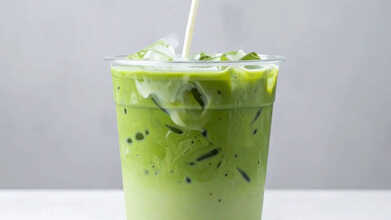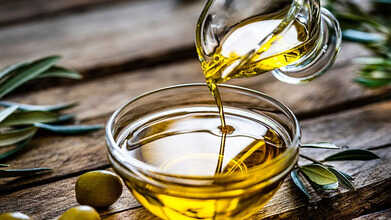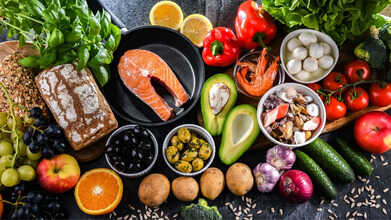- Health Conditions A-Z
- Health & Wellness
- Nutrition
- Fitness
- Health News
- Ayurveda
- Videos
- Medicine A-Z
- Parenting
- Web Stories
Are Bananas A Bad Choice For Weight Loss?

Image Credit: Health and me
Bananas are among the most commonly consumed fruits worldwide. They are easily available, affordable, and highly versatile. Whether eaten as a snack, blended into smoothies, or paired with peanut butter, bananas offer both convenience and nutrition. However, when it comes to weight loss, some people question whether bananas are a suitable choice due to their natural sugar and carbohydrate content. So, are bananas really bad for weight loss?
Bananas are often categorized as a high-calorie fruit compared to berries and citrus fruits, but they are packed with essential nutrients that contribute to overall health. A medium-sized banana contains approximately 105 calories, most of which come from carbohydrates. However, it is also a rich source of fiber, vitamins, and minerals, which play a crucial role in maintaining a healthy diet.
Key Nutrients in Bananas
Potassium: 12% of the Recommended Dietary Intake (RDI) – Supports heart health and muscle function.
Vitamin B6: 20% of the RDI – Helps with metabolism and brain health.
Vitamin C: 17% of the RDI – Aids in immunity and skin health.
Fiber: 3.1 grams – Supports digestion and promotes satiety.
Magnesium and Manganese: Aid in bone health and metabolism regulation.
Bananas are naturally low in fat and protein, making them primarily a carbohydrate-based food. The way your body processes these carbohydrates influences whether they support or hinder weight loss efforts.
Bananas and Weight Loss
1. The Role of Fiber in Satiety
One of the main reasons bananas are considered beneficial for weight loss is their fiber content. A medium banana provides around 3 grams of fiber, which contributes to prolonged feelings of fullness. High-fiber foods slow down digestion, reduce hunger cravings, and prevent overeating.
Studies suggest that individuals who consume more fiber tend to have healthier body weights. Fiber-rich diets help regulate blood sugar levels and prevent insulin spikes, which are often linked to weight gain and cravings for unhealthy snacks.
2. Caloric Density and Portion Control
While bananas contain more calories than some other fruits, they are still a moderate-calorie food that can fit into a weight-loss plan. The key is portion control. Eating one banana as a snack or adding it to a meal in a balanced way can contribute to satiety without leading to excessive calorie intake.
However, consuming multiple bananas daily in place of other nutrient-dense foods could result in an imbalanced diet, as bananas are low in protein and healthy fats, both of which are essential for overall well-being.
3. Resistant Starch in Unripe Bananas
The ripeness of a banana affects its carbohydrate composition. Unripe bananas contain higher levels of resistant starch, a type of carbohydrate that acts like fiber. Resistant starch is not fully digested in the small intestine, meaning it contributes fewer calories and helps maintain stable blood sugar levels. Additionally, it promotes the growth of beneficial gut bacteria, which may support weight management.
4. Glycemic Index and Blood Sugar Impact
The glycemic index (GI) measures how quickly a food raises blood sugar levels. A ripe banana has a GI score of 51, which is considered moderate. In comparison, pure glucose has a GI of 100, and table sugar has a GI of 65.
For individuals managing blood sugar levels, such as those with insulin resistance or diabetes, consuming bananas in moderation is recommended. Pairing bananas with protein or healthy fats, like Greek yogurt or nut butter, can help slow the absorption of sugar into the bloodstream, minimizing insulin spikes.
5. Comparing Bananas to Other Fruits
Although bananas are a good source of fiber, other fruits offer even higher fiber content per serving. For example:
Raspberries contain twice the amount of fiber as bananas.
Apples, pears, and oranges also provide comparable fiber levels with lower sugar content.
If weight loss is the primary goal, incorporating a variety of fiber-rich fruits into your diet may provide more balanced nutrition while keeping calorie intake in check.
Can You Include Bananas in a Weight-Loss Diet?
Rather than eliminating bananas from your diet, the key is to consume them strategically:
Pair bananas with protein or healthy fats: Eating bananas with sources of protein (such as eggs or yogurt) or healthy fats (like almond butter) can slow digestion and promote satiety.
Opt for unripe bananas when possible: Green bananas contain more resistant starch, which aids digestion and blood sugar regulation.
Monitor portion sizes: Stick to one banana per serving and balance it with other nutrient-dense foods.
Use bananas as a natural sweetener: Instead of processed sugar, use mashed bananas in oatmeal, smoothies, or baked goods to cut down on added sugar.
So, Should You Eat Bananas While Trying to Lose Weight?
Bananas are not inherently bad for weight loss. In fact, they offer several benefits, including high fiber content, essential vitamins, and a natural source of energy. However, like any food, moderation is key. Overconsumption can lead to excessive calorie intake, which may hinder weight loss efforts. Ultimately, bananas can be part of a successful weight-loss strategy when consumed mindfully and in conjunction with a balanced diet and regular exercise.
Can Overconsumption of Matcha Impact Your Heart and Overall Health?

Credits: Canva
While matcha has become a favourite for many, it comes with its own set of benefits and cautions. Celebrated for its energising properties and health perks, matcha is not completely risk-free. Overdoing it can lead to certain health issues. Recent research suggests that excessive matcha consumption can affect the heart and digestion. We spoke to Dr. Rahul Mehrotra, Chief - NIC & Clinical Cardiology, Artemis Hospitals, to understand more.
How Overconsumption of Matcha Can Impact Your Heart or Health?
Matcha, the finely powdered green tea, is rich in antioxidants, especially catechins and is popular for its potential health benefits. But as with most superfoods, moderation is essential. Drinking more than 2–3 cups a day may lead to issues, particularly for heart and digestive health.Matcha contains caffeine, and consuming it in large amounts can increase heart rate, cause palpitations, raise blood pressure, or trigger anxiety in sensitive individuals. While L-theanine in matcha usually has calming effects, too much caffeine can overpower this balance.
Digestively, matcha is slightly acidic. Overconsumption can lead to stomach upset, acid reflux, or constipation, especially on an empty stomach. Additionally, matcha can interfere with iron absorption from plant-based foods, potentially raising the risk of iron deficiency over time if your diet isn’t balanced.
While matcha offers notable benefits such as improved metabolism and focus, taking too much may offset these advantages. The best approach is moderate consumption as part of a balanced diet.
Benefits of Moderate Matcha Consumption
When enjoyed in moderation, matcha can be a healthful addition to your daily routine. Here are some of the main benefits:- Sustained Energy Boost: Matcha provides a smooth, long-lasting energy lift without the jitters of coffee, thanks to the combination of caffeine and L-theanine. This helps maintain steady energy throughout the day.
- Rich in Antioxidants: Packed with catechins, matcha helps neutralise harmful free radicals, supports overall wellness, and can promote liver health.
- Enhanced Focus and Relaxation: L-theanine in matcha encourages calmness while enhancing concentration, making it an excellent drink for mental clarity.
- Boosts Metabolism: Regular matcha consumption may help improve metabolism and support fat burning, assisting with weight management when paired with a healthy lifestyle.
- Supports Heart Health: Drinking matcha regularly may aid in regulating blood sugar, reducing blood pressure, and lowering bad cholesterol, all of which contribute to heart health.
According to Dr. Rahul Mehrotra, enjoying matcha sensibly allows you to harness its benefits without risking adverse effects on your heart or digestion.
How Much Matcha Should You Consume?
When it comes to drinking matcha, moderation is essential. Here are some general guidelines for safe consumption:- One to Two Cups Per Day: Most experts suggest limiting matcha to one or two cups daily.
- Caffeine Limit: Make sure your total caffeine intake—from matcha and other sources—does not exceed 400 milligrams per day.
- Pregnant Women: Expecting mothers should be careful with matcha and other caffeinated drinks to avoid potential complications.
- Caffeine Sensitivity: If you are sensitive to caffeine, it’s wise to reduce your matcha intake to prevent side effects like jitteriness or palpitations.
- Age and Health Considerations: Older adults or people with conditions such as high blood pressure should check with a doctor before increasing their matcha consumption.
Those with higher caffeine tolerance might handle more matcha without issues, while younger individuals or those with underlying conditions, such as liver problems or high blood pressure should approach it with extra caution.
MCT Oil Explained: Benefits, How To Use It, And Why It’s Gaining Popularity

Credits: Canva
MCT oil has become a popular supplement in the world of health and wellness, often praised for its ability to boost energy, support weight management, and improve brain function. Derived from medium-chain triglycerides, fats that are more easily digested and converted into energy than long-chain fats.
Whether you are an athlete, someone looking to support cognitive health, or simply exploring healthier fat options, understanding what MCT oil is, how to use it, and why it has gained so much attention can help you decide if it belongs in your daily routine.
What Is MCT Oil?Medium-chain triglyceride (MCT) oil is a processed oil typically derived from coconut or palm kernel oil, though small amounts of MCTs are also naturally present in foods like dairy. As the name suggests, MCT oil contains medium-length chains of fats called triglycerides. Because these fatty acids are shorter than the long-chain fats found in many other foods, the body can digest and convert them into energy more quickly.
There are four main types of medium-chain fatty acids: lauric acid, caproic acid, caprylic acid, and capric acid. MCT oil is made up almost entirely of caprylic and capric acids, which are thought to be the most easily absorbed and metabolised by the body.
MCT oil is versatile and easy to add to your daily routine, but it’s best to start small to see how your body responds. Begin with 1 teaspoon a day and gradually increase to 1–2 tablespoons if tolerated. Here are some simple ways to use it:
- In your morning coffee or tea: Blend it in for a creamy texture and sustained energy.
- Smoothies and shakes: Add a spoonful for an extra boost of healthy fats.
- Salad dressings or sauces: Use it as a light base or mix with olive oil.
- Cooking: MCT oil has a low smoke point, so it’s best for drizzling over foods rather than frying or high-heat cooking.
Why Is MCT Oil Getting So Popular?
MCT oil has surged in popularity because of its reputation as a quick and efficient source of energy and its potential health benefits. Unlike longer-chain fats, MCTs are rapidly absorbed by the body and converted into fuel, making them a favorite among athletes, busy professionals, and anyone looking for an energy boost.Additionally, studies suggest that MCT oil may support weight management, improve mental clarity, and even aid digestion. It is is easy to add to coffee, smoothies, or salad dressings which also makes it an attractive option for those seeking a simple way to incorporate healthy fats into their diet.
MCT Oil: Benefits
Research suggests MCT oil may support weight management, improve cognitive function, and provide a quick source of energy since it is metabolized faster than other fats. Some studies also point to its role in reducing risk factors for heart disease and aiding people with digestive issues who struggle to absorb fats. For example, a 16-week clinical trial published in the American Journal of Clinical Nutrition found that participants using MCT oil lost more body weight compared to those using olive oil.While MCT oil is not a magic fix, it can be a useful addition to a balanced diet when taken in moderation. Its potential benefits for energy, metabolism, and brain health make it popular among health enthusiasts, but it is important to consult a doctor before making it a regular part of your routine. Choosing high-quality MCT oil and using it wisely can help you enjoy its advantages without unwanted side effects.
Mediterranean Diet Could Lower Alzheimer’s Risk by 35%, Study Finds: How It Supports Brain Health

Credits: Canva
Taking care of our brains should be a top health priority. After all, the brain controls nearly every function in our body. As we age, however, our brain function naturally declines, and the risk of dementia rises. Dementia is a term that covers memory loss and other cognitive difficulties that significantly affect daily life. Current data suggest that the number of dementia cases—now around 514,000 per year, could double by 2060, highlighting the urgent need for ways to protect the brain.
Research shows that lifestyle choices have a major impact on brain health. But did you know that certain diets can help lower your risk of Alzheimer’s? Here’s what you need to know.
What is Mediterranean Diet?
The Mediterranean diet is a plant-focused way of eating, inspired by the traditional diets of Mediterranean countries. It emphasizes fresh fruits and vegetables, whole grains, legumes, nuts, seeds, and olive oil as the main source of fat. The diet includes moderate amounts of fish and dairy while limiting red meat and sweets. Beyond what’s on the plate, it also encourages lifestyle habits such as regular physical activity and sharing meals with others, which supports social connections and helps reduce stress.Mediterranean Diet Could Lower Alzheimer’s Risk by 35%
A long-term study conducted by the Nurses’ Health Study (NHS), which followed female nurses from 1989 to 2023, found that people who closely followed the Mediterranean diet over the years had a significantly lower risk of dementia and better cognitive function. This protective effect was particularly evident in individuals with varying genetic risk for Alzheimer’s, including carriers of the APOE-e4 gene. Similar findings were also observed in the male Health Professionals Study.ALSO READ: Diet For Mental Health: How Keto Helps With Depression
While the Mediterranean diet as a whole was linked to reduced dementia risk, researchers highlighted a few key components that seem to have the most impact: fresh fruits, nuts, and sources of monounsaturated fats, such as olive oil and avocados.
The study indicates that sticking to the Mediterranean diet over the long term may substantially lower the risk of Alzheimer’s, even for those with a genetic predisposition. This diet is packed with fiber, antioxidants, healthy fats, and lean proteins, found in foods like fruits, vegetables, nuts, seeds, legumes, whole grains, seafood, and olive oil. Incorporating more of these foods into your daily meals can be a simple way to support brain health.
How To Follow a Mediterranean Diet?Incorporating the Mediterranean diet into your daily routine doesn’t have to be complicated. Start by adding more fresh fruits and vegetables to every meal, swapping refined grains for whole grains, and including nuts, seeds, and legumes as snacks or salad toppings. Use olive oil as your main cooking fat instead of butter or processed oils, and aim to include fish or seafood a few times a week.
ALSO READ: Never Eat Chia Seeds THIS Way: Doctor Warns Of Hidden Dangers
Red meat and sweets can be enjoyed occasionally, rather than daily. Beyond food, try to stay active through walking, yoga, or other forms of exercise, and make mealtimes a social experience whenever possible, sharing meals with family or friends to combine nutrition with connection and reduced stress.
For personalised guidance, consulting a registered dietitian can help you create a plan that fits your tastes and lifestyle.
© 2024 Bennett, Coleman & Company Limited

